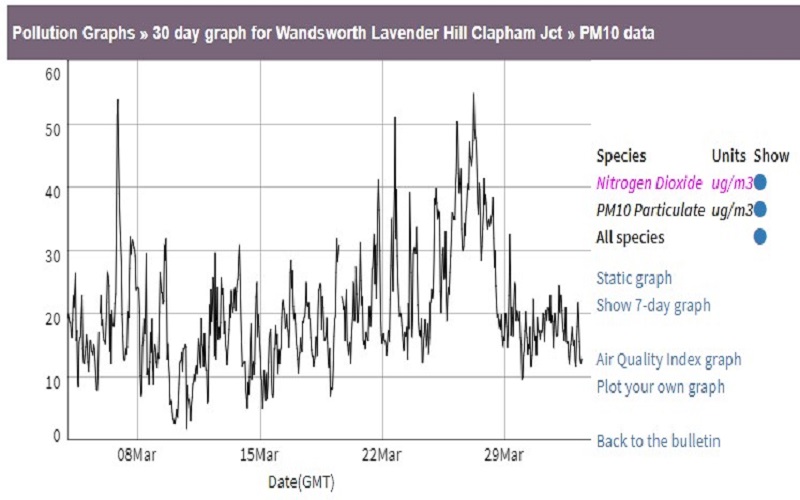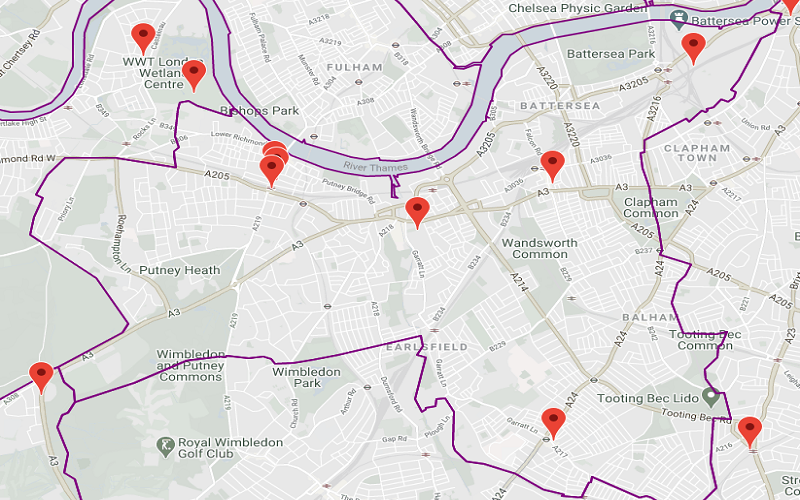By Kyle Farrell
April 12 2020, 12.25
Follow @SW_Londoner
Air pollution in Wandsworth has worsened despite the nationwide lockdown.
London Air data showed an increase in Nitrogen Dioxide (NO2) and PM10 pollutants with some of the highest monthly peaks seen after March 23.
Experts point to cold weather and central heating as the potential cause for these increases.
This comes as people are told to not venture outside unless for specific reasons.
Project manager at air filtration company Elta Group, Ana Cross, said: “A still atmosphere, no wind, low temperatures, and sunny day can lead to ground-level ozone forming which can create NO2.
“Low temperatures also could mean more people are staying at home and ramping up their central heating which contributes to pollution.”
Weather forecasts show that Wandsworth saw some morning lows of -2oc after March 23.
Nitrogen Oxide is a pollutant released when fuels are burnt – such as in cars, heaters, or power stations.
The burning of fossil fuels is the primary source of NO2 with atmospheric reactions as the second.
The gas can cause damage to plant life and lungs.
PM10 is a combination of Sulfur Dioxide, Nitrogen Dioxide, Carbon Monoxide, and soot, which are 10 micrometers or less in diameter.
The Wandsworth Town Hall monitoring site saw average NO2 levels of 57.1 micrograms per cubic meter of air (ugm3) between 23rd-31st March.
The total March NO2 average was 48.2ugm3 – a difference of 8.9.
Wandsworth Town Hall also saw a sharp NO2 peak on Wednesday March 25 around 6am of 175.4ugm3.
NO2 averages for previous March Wednesdays were roughly 93.6ugm3.
Putney High Street saw a decrease in NO2 but PM10 levels have risen.
The March PM10 average was 16.2ugm3 but between 23-31 March that average increased to 18.5ugm3 – a difference of 2.3.
PM10 levels on Thursday March 26 around 7am also saw a PM1O spike of 43.6ugm3
Thursday PM10 averages for the month were roughly 18.4ugm3.
Air quality analyst at King’s College University, Timothy Baker, looks after the data from London Air and said it’s common to see pollution from blow over from Europe at this time of year.
He added: “But this rise was nowhere near the usual amount due to continental restrictions.”
Urban air quality expert, Jo Barnes, agrees the weather may be responsible.
Dr Barnes highlights an Air Quality Consultants report which showed a 20 per cent reduction in NO2 at London Marylebone Road in Westminster when weather influence was taken out of the equation.
David Smith, 43, lives in Wandsworth. His family has respiratory problems.
He said: “We try to avoid main roads on our journey and I worry about pollution on my son’s physical and mental development.”
Since the school closures, Mr Smith has noticed his daughter does not use her inhaler as much due to being indoors.
Despite the increase in Wandsworth, the World Health Organisation’s air quality standards say these are still low amounts.
Research from The Department for Environment, Food and Rural Affairs (DEFRA) showed air pollution has decreased generally across the UK.
NO2 hourly levels of 200ugm3 or PM10 levels of 50ugm3 are considered moderate but should not be exceeded.







